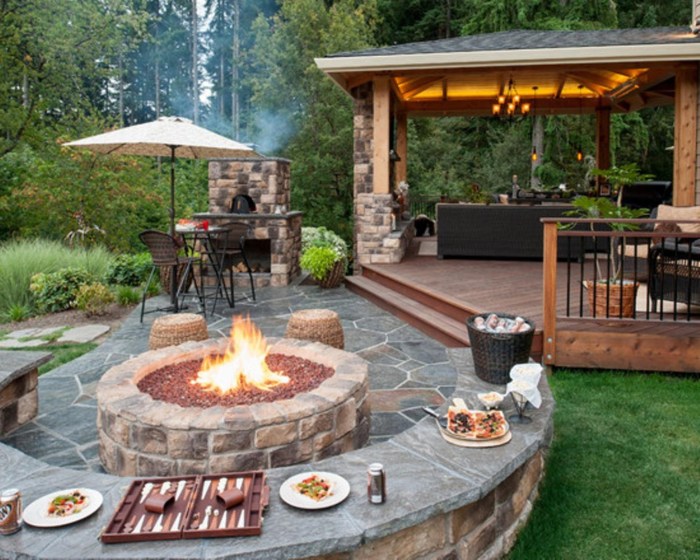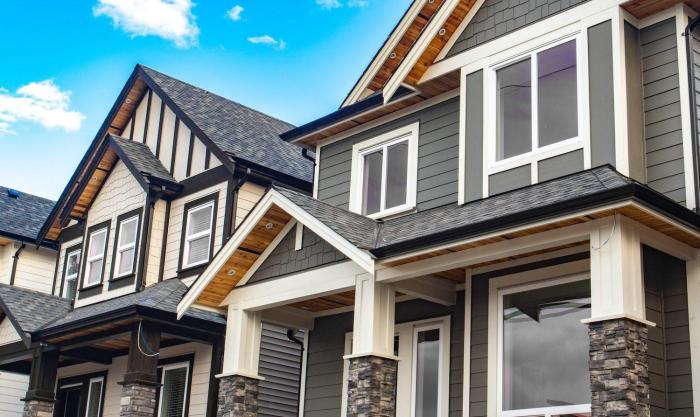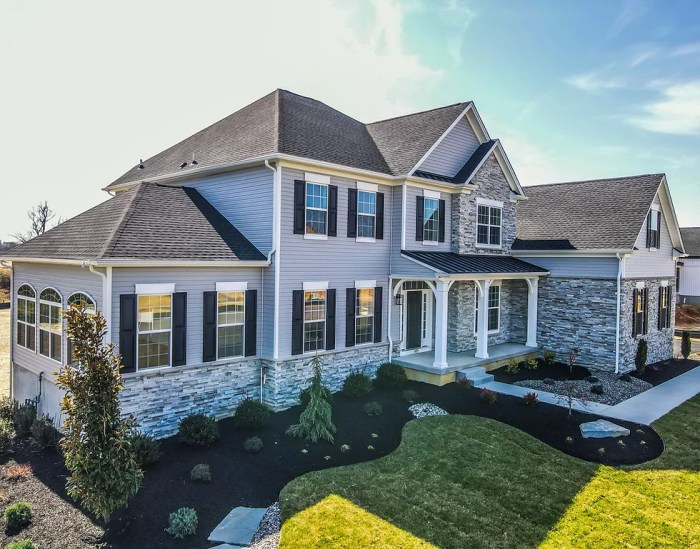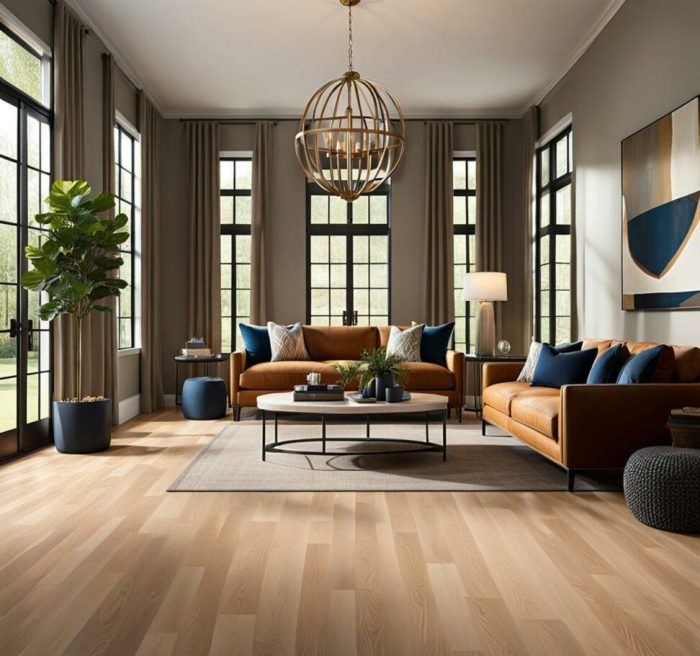Crafting a Stunning Board and Batten Home Exterior
Embark on a journey into the world of board and batten home exteriors, where classic charm meets modern design. Discover the unique appeal and versatility of this timeless siding option that can transform any home into a work of art.
Delve deeper into the intricacies of board and batten exteriors, from their rich history to the practical benefits they offer for homeowners seeking a distinctive look for their houses.
Overview of Board and Batten Home Exterior
Board and batten siding is a type of exterior cladding that features alternating wide boards (the "boards") and narrow strips (the "battens"). This design creates a visually appealing vertical pattern on the exterior of a home.
History and Origin of Board and Batten Exteriors
The use of board and batten siding dates back to the 19th century when it was commonly used in American architecture, particularly in rural and agricultural settings. The style was popular due to its simplicity, durability, and ease of installation.
Benefits of Using Board and Batten for Home Exteriors
- Architectural Appeal: Board and batten siding adds a unique and charming look to a home, creating a timeless aesthetic.
- Weather Resistance: The vertical design helps shed water and protect the underlying structure from the elements.
- Insulation: The overlapping boards and battens provide an extra layer of insulation, improving the energy efficiency of the home.
- Low Maintenance: Board and batten siding requires minimal upkeep and can last for many years with proper care.
Design and Style Considerations
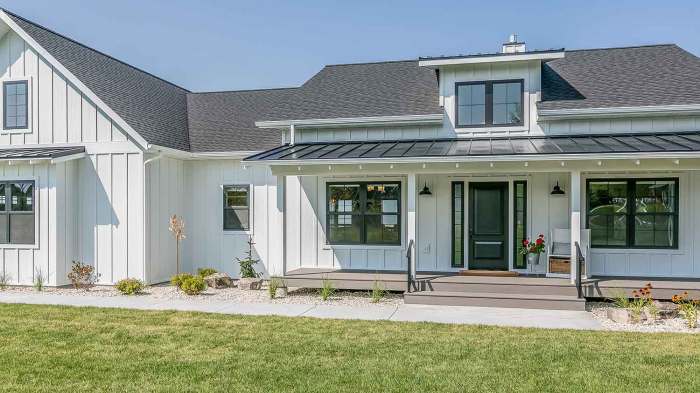
When it comes to board and batten designs, there are several variations that can be incorporated to achieve different looks and styles. The two main variations include traditional board and batten, where wide boards are spaced evenly apart with narrow battens covering the gaps, and reverse board and batten, where the battens are placed in the front with the boards behind them.
These variations can create unique visual effects and add character to the exterior of a home.Board and batten exteriors can complement various architectural styles, ranging from rustic farmhouse to modern contemporary. In a farmhouse setting, the traditional board and batten design can enhance the rustic charm of the home, while in a more modern architecture, the reverse board and batten style can add a sleek and minimalist touch.
The versatility of board and batten makes it a suitable choice for a wide range of architectural styles.Color choices play a crucial role in determining the overall look of a board and batten exterior. Lighter colors, such as white or light gray, can give a fresh and clean appearance, ideal for a coastal or cottage-style home.
On the other hand, darker colors like navy blue or forest green can create a bold and dramatic look, perfect for a more traditional or craftsman-style home. The color scheme chosen can significantly impact the curb appeal and aesthetic appeal of a board and batten exterior.
Installation and Maintenance
When it comes to board and batten siding, proper installation and maintenance are key to ensuring the longevity and aesthetic appeal of your home's exterior.
Installing Board and Batten Siding
- Start by preparing the surface of your home by removing any existing siding and ensuring the area is clean and free of debris.
- Measure and cut the boards to the desired length, making sure to leave enough space between each batten for expansion and contraction.
- Secure the boards to the exterior of your home using nails or screws, ensuring they are level and properly spaced.
- Install the battens vertically over the boards, creating the classic board and batten look.
- Finish by painting or staining the siding to protect it from the elements and enhance its appearance.
Maintaining a Board and Batten Exterior
- Regularly inspect the siding for any signs of damage, such as cracks, rot, or pests, and address them promptly to prevent further issues.
- Clean the siding annually with a mild detergent and water to remove dirt, mold, and mildew buildup.
- Repaint or restain the siding every few years to maintain its protective coating and keep it looking fresh and vibrant.
- Trim back any vegetation near the siding to prevent moisture buildup and potential damage.
Comparing Durability of Board and Batten Siding
- Board and batten siding is known for its durability and longevity, especially when properly installed and maintained.
- Compared to other siding materials like vinyl or aluminum, board and batten siding can be more susceptible to moisture damage if not properly maintained.
- However, with regular inspections, maintenance, and proper care, board and batten siding can last for many years and provide a timeless look to your home.
Cost and Sustainability
When considering board and batten for a home exterior, it is essential to analyze both the cost implications and sustainability aspects of this siding option.
Cost Implications
Choosing board and batten siding can have varying costs depending on the type of wood used, the size of the boards, and the overall size of the project. Typically, cedar is a popular choice for board and batten due to its durability and aesthetic appeal.
While cedar may be more expensive upfront, it requires less maintenance and can last for many years, potentially saving on long-term costs. Other factors that can impact the cost include installation fees, labor costs, and any additional treatments or finishes desired.
Sustainability Aspects
Board and batten siding can be a sustainable option for a home exterior. Using wood sourced from responsibly managed forests ensures that the environmental impact is minimized. Cedar, in particular, is known for its sustainability as it is a renewable resource.
Additionally, the longevity of board and batten siding can contribute to sustainability by reducing the need for frequent replacements, which in turn reduces waste.
Eco-Friendly Options and Treatments
- Consider using reclaimed wood for board and batten siding to reduce the demand for new materials and give a unique character to the exterior.
- Opt for water-based finishes and treatments to minimize harmful chemicals that could impact the environment.
- Explore natural treatments like linseed oil or beeswax to protect the wood and enhance its longevity without harsh chemicals.
Final Thoughts
In conclusion, board and batten siding isn't just a design choice – it's a statement. With its durability, aesthetic appeal, and sustainability, it's a winning option for those looking to elevate their home's exterior. Embrace the beauty and functionality of board and batten, and watch your home shine.
Question & Answer Hub
Are board and batten exteriors only suitable for traditional homes?
Not at all! Board and batten siding can complement a variety of architectural styles, from modern to farmhouse.
How difficult is it to maintain a board and batten exterior?
Maintenance is relatively easy – occasional cleaning and inspections are usually all that's needed to keep it looking great.
Is board and batten siding environmentally friendly?
Yes, it can be sustainable. Opting for eco-friendly treatments and materials can enhance its green credentials.
